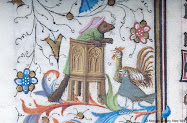While I was wittering on about learning Russian, Belle posted a link to this most beguiling piece of performance art. The things this woman does with sand are amazing, and her tracing of recent Ukrainian history is entrancing and chilling at the same time.
(Click here if you can't play the embedded version below.)
Thursday, January 28, 2010
Subscribe to:
Post Comments (Atom)




8 comments:
That is a fascinating and beautiful piece. To me, it tells of the ability of people from Eastern Europe to be creative with very little, to beguile with simplicity. It reminds me of the transitory nature of their society, swept over by one invader after another, yet their ability to transcend each storm. It speaks of a society superficially simple yet deep down complex. I can see how it might move people from that land to tears, for it is a profound and heart-felt piece of work.
This is absolutely amazing - I am so glad you posted it. It was clearly very moving to its audience and no wonder - and, as what do we all pound down to but a few grains of sand - a marvelous medium to convey the sandstorm that is history and not only in Eastern Europe
I make it a rule not to watch mini videos on blogs; but, my rule was well and truly broken on this one. (I'll mull over the why's and wherefores).
As the performance started, I thought 'so what' I've seen many similar artists, well rehearsed do similar things with other media. However, as the historical journey continued, with Russian commentary and appropriate musical in the back ground, I was emotionally hooked. I noticed some of the audience were as well.
When will we ever learn?
Have you started on the Cyrillic alphabet yet?
I'm glad you all found it worth watching.
ZACL - my classes start next week so no alphabet teaching yet, but I've taken a peek at the textbook - eek!
My youngster is a passionate student of Russian.
You'll be fine.
I've never studied Russian, but I've just been learning some NT Greek, for which we also had to get to grips with a new alphabet. A few weeks practice and everyone in the group was fine with it. One of the best exercises I found to get to grips with the alphabet was just practising transliteration. Take a few words in the new alphabet (names are best, because you'll probably recognise the transliterated forms of them) and write down the English equivalent of each letter. Even if you start off needing to look at the chart every second letter, by the time you've done that for 10-20 names, it starts becoming a lot easier.
Interesting you say that....when in Cyprus, using names for transliteration was exactly what I did. The older brain,like mine, holds on such associations more easily.
That is a great tip! I'm sure I will be putting that to use in the next few weeks.
Post a Comment